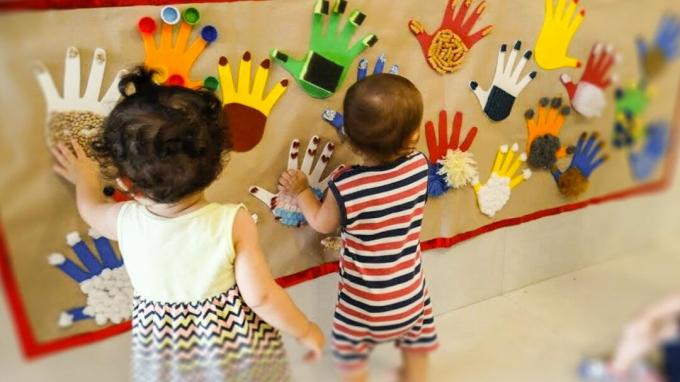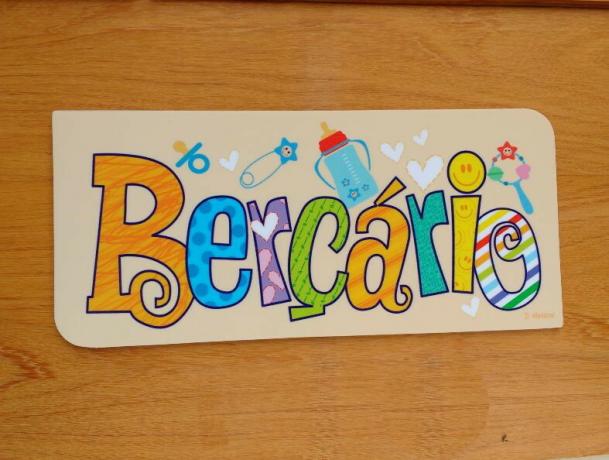We selected in this post several games, dynamics and Activities for Nursery 1 and 2 ready to work with their students in classroom.
There are several suggestions to stimulate the child's motor development with activities appropriate for each age.
Encouraging psychomotor, social and affective development is essential for the overall development of children
Index
GOALS: Recognize your own name and strengthen your bond with the educator. Choose a song in which you can include the children's names. Some examples: “Se Eu Fosse um Peixinho”, “A Canoa Virou”, “Ciranda, Cirandinha” and “Fui ao Itororó”. Gather the group in a nice place and sing. Babies can also participate, as the intention is to familiarize them with the names. To those who are already walking, suggest a wheel, which is formed with those who hear their own name.
See too: Literacy Activities.
PREPARATION: In a saucepan, dissolve one tablespoon of cornstarch for every glass of water. The amount depends on the number of children or the size of the space where the activity will take place. Add a pinch of dye until the mixture is the color you want. Bring it to the fire and stir until it turns into a mush. Let cool. Tell parents to send old clothes on play day. Spread the mixture on the floor of the room where the children will play. Let them walk, crawl and roll on the mush, interacting with space. Make sure everyone has fun and no one gets hurt. Encourage the various possibilities for movement.

The benefits of the sensory box for the child:
Despite so many benefits the sensor box is actually something very simple. It is a box (usually plastic) with a lining (a bottom, which can be made, for example, with beans, rice, mate, noodles, water, gelatin, etc.) and interesting objects (with an attractive look and texture) and usually presented and organized from a theme.
So, the first step in creating your sensory box is choosing a theme. Then, just assemble it by creating a background and inserting the themed objects.
It is important to present the box and each object to the child and let them explore their senses with this fun activity.
Be careful when choosing the items that will make up the box, remembering that small children tend to take the objects to the mouth, which is why it is recommended to avoid very small objects and to supervise the Just kidding.
Get inspired by the examples below, use your creativity and assemble sensory boxes with the most diverse themes!

GOALS: Become part of the group and collaborate with colleagues. PREPARATION: Glue a picture or draw a cardboard-sized tree filled with branches to serve as a board. Make berries out of clay, let them dry and paint them with the same colors as the dice that will be used in the game. On one of his faces, draw a little bird. Also make origami baskets or arrange bowls with the same colors as the die and provide a toy in the shape of a bird. Place the tray on a table and spread the berries over the branches. The bird must stay loose. Around the board, spread out the colored baskets. Game for four children. One child at a time throws the die, takes the fruit of the same color indicated by the die from the tree and puts it in the basket, also of the same hue. If the die lands on the face that brings the bird, it is the bird who gets the fruit. The objective is to harvest them all before the bird eats them.
We also recommend: Cuca drawings to color.
Check out several suggestions for playful games to work in the nursery.
Suggestions for activities and stimuli for the nursery:

Hide and Seek (for babies) – This game can be worked from 6 months.
Fittings (for babies) – From 6 months.
One box within another and the baby learns what is big, small, light and heavy.
The colors – Working from 3 months.
Blue and red foam blocks… One on top of the other and suddenly everyone on the floor!
_____

Check out some Templates letter a.

Great Nursery Activities (0-2 years) with the objective of harmoniously developing the physical, psychic and social aspects of the baby, respecting their emotional maturity. Develop the child's psychomotricity through the body and movement.
ACTIVITIES:
Subscribe to our email list and receive interesting information and updates in your email inbox
Thanks for signing up.